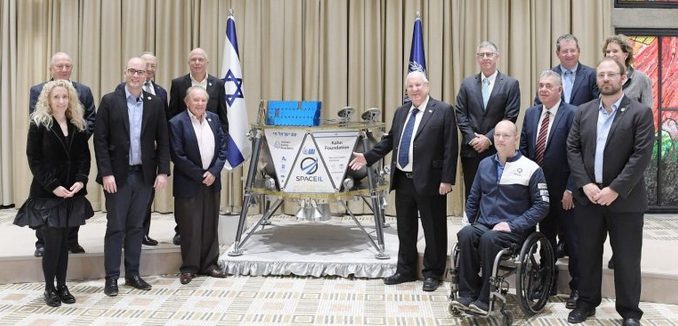After eight years of preparations by 250 people, $100 million and a large dose of Israeli chutzpah, the SpaceIL Israeli unmanned spacecraft Beresheet is scheduled for liftoff from Cape Canaveral Kennedy Space Center at 8:45pm February 21 local Florida time, aiming to reach the moon on April 11.
At a prelaunch press conference, SpaceIL and Israel Aerospace Industries (IAI) officials and the project’s main donor, Morris Kahn, were beaming as they described their pride in what will be the first-ever commercial, non-governmental mission to the moon.
The name Beresheet (“in the beginning” or Genesis, the first word in the Bible) was chosen by popular vote. IAI Space Division General Manager Opher Doron quipped that maybe the craft’s name should have been Chutzpah, which translates as “nerve,” “moxie” or “audacity.”
Indeed, Kahn said most people he approached for donations to put a spacecraft on the moon thought he had lost his marbles.
“It was very difficult to raise money for this mission because it was really a mission impossible,” said Kahn. “I didn’t realize it was impossible and the three engineers who started this project didn’t realize it was impossible, and the way we in Israel think, nothing is impossible. We dare to dream. And we really are making this dream come true.”
The 160-kilo Beresheet craft, built at Israel Aerospace Industries, will be the smallest spacecraft ever sent to the moon, and the first one from a small country (the predecessors were the United States, Russia and China).
Onboard is a time capsule containing hundreds of digital files including a nano Bible, details about SpaceIL, Israeli national symbols and Israeli children’s drawings. The craft also carries instruments to measure the magnetic field of the moon.
In another very Israeli touch — as Israelis often get around the country by hitchhiking — Beresheet marks the first time a spacecraft will be hitching a ride to the moon. It will be launched from a SpaceX Falcon 9 rocket carrying three satellites.
SpaceIL CEO Ido Anteby said there are five big challenges ahead for Beresheet: the launch itself, communication, withstanding the seven-week journey of more than 6.5 million kilometers, lunar capture and the actual landing.
“There is always some danger but we are convinced we will be successful,” Anteby said, adding that cooperation with US space agency NASA has been a critical component of getting the project off the ground.
SpaceIL, an independent initiative started in 2011 by Yariv Bash, Kfir Damari and Yonatan Weintraub also was designed to inspire children to learn about science.
Antebi said the Education Ministry and Israeli Space Agency have prepared a kit for teachers to use with students on the day of launch and over the next two months “explaining what the spacecraft will do and encouraging the kids to think big and choose STEM subjects.”
“The importance of the program is getting Israeli kids super excited about technology, to feel they can do anything,” said Doron of IAI. “It’s a great technological achievement but also a huge educational achievement.”
For educators and parents outside of Israel, The iCenter has released The Landing Page – An Educator’s Launch Kit including STEM activities, Hebrew materials, stories, videos, Moon Party Spotify playlists, and more.
Watch ISRAEL21c for further coverage of the SpaceIL liftoff and journey.
(via Israel21c)
[Photo: Israel21c ]




